Krabi-Krabong: The Thai Art of Swords and Staffs
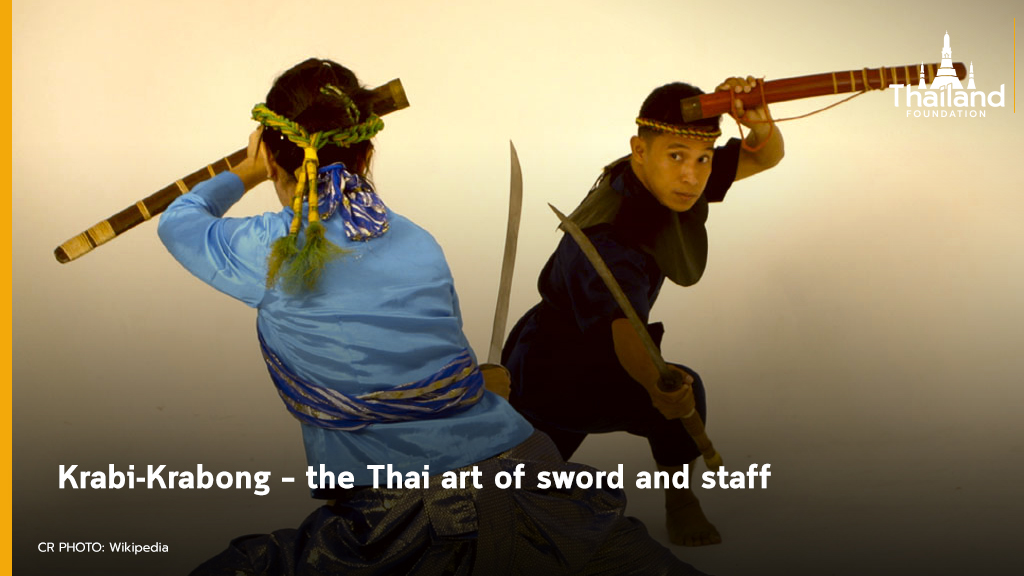
Krabi-Krabong [กระบี่กระบอง] is an ancient Thai martial art that may sound rather unfamiliar to most people since this art form is only known as far as the border of Thailand and has never seen international or even regional competitions. Krabi-Krabong is included in the physical education curriculum in Thailand, but even that, not all Thais know or appreciate this elegant and charming martial art. In this article, we are going to dive into this mysterious martial art together, from its origins, moves, weapons, to beautiful rituals that come with it.
What is Krabi-Krabong?
Krabi-Krabong literally means “a saber and a mace,” but in this marital art, it refers to two groups of weapons, which will be discussed later on. This weapon-based practice was developed as a peacetime drill. The ancient Thai people would use rattan to make training equipment like krabi (sabers), daab (swords), ngao (halberds), and so on while leather would be a material for making lo (round shields), khen (angular shields), or daang (in-fighting shields), and etc. Fighters will pair up to practice or compete as if they were really fighting on the battlefield.
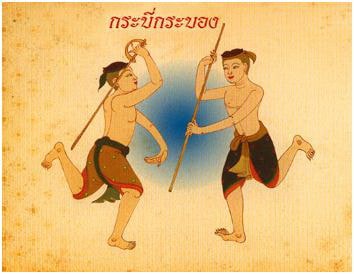
(photo credit: https://www.educatepark.com/story/history-of-krabi-krabong/)
History
We do not know the origin of Krabi-Krabong or who invented it. As far as we could trace back, Krabi-Krabong was first mentioned in the literature in the early Rattanakosin era (1782-1851). In “Inao,” the composition of King Rama II (1809-1824), Inao, the protagonist of the story, was a skilled swordsman. In the reign of King Rama III (1824-1851), Sunthorn Phu, a renowned Thai poet, composed “Phra Aphai Mani” and mentioned Krabi Krabong.
During the reigns of King Rama IV (1851-1868) and King Rama V (1868-1910), Krabi-Krabong was popularized and well promoted. King Rama IV encouraged his sons to practice this martial art and ordered that Krabi-Krabong performances be organized at any grand celebrations. King Rama V, being a Krabi-Krabong enthusiast himself, supported many Krabi-Krabong competitions and awards, as well as other martial arts, like Thai kickboxing. This era was considered the golden age of Krabi Krabong, and saw the emergence of many clubs and schools.
However, during the reign of King Rama VI (1910-1925), the popularity of Krabi-Krabong started to die down as the king favored other art forms. Later in the reign of King Rama VII (1925-1935), it was almost impossible to find public Krabi-Krabong performances.
No matter how gloomy the outlook was, that was not the end. Passionate about Krabi-Krabong since a young age, Teacher Nak Thephasadin Na Ayudhya devoted himself to preserving the art. When he became the principal of the Central Physical Education School, he ran a Krabi-Krabong class in 1935, which was the first time this martial art was taught in school, and since 1975, the Ministry of Education has included it in the national physical education curriculum.
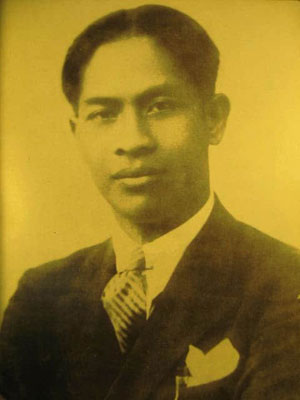
Teacher Nak Thephasadin Na Ayudhya
(photo credit: https://www.educatepark.com/story/history-of-krabi-krabong/)
Weapons Used
Krabi and Krabong are the names for short and long weapons, respectively. In literature, the Ramayana in particular, giant characters which are gigantic and slow-moving are armed with maces and batons while small and nimble monkey characters wield shorter weapons, such as knives, swords, or sabers. In other words, “Krabi” (sabers) refers to all close-range weapons (sabers, swords, shields, daggers, knives, scythes, axes, short-handle tridents, and short-prongs). “Krabong” (maces) covers all long-range weapons (staffs, maces, halberds, javelins, lances, spears, etc.).
Categorized by purposes, the weapons used in Krabi-Krabong also fall into two groups: the dance equipment and the fight equipment. The dance equipment is lacquered and gilded beautifully with gold leaves or with glass. On the contrary, the fight equipment is not embellished. All of the weapons used in Krabi-Krabong are not real weapons, thus far less dangerous. Most of them are made of rattan which is tough and lightweight.
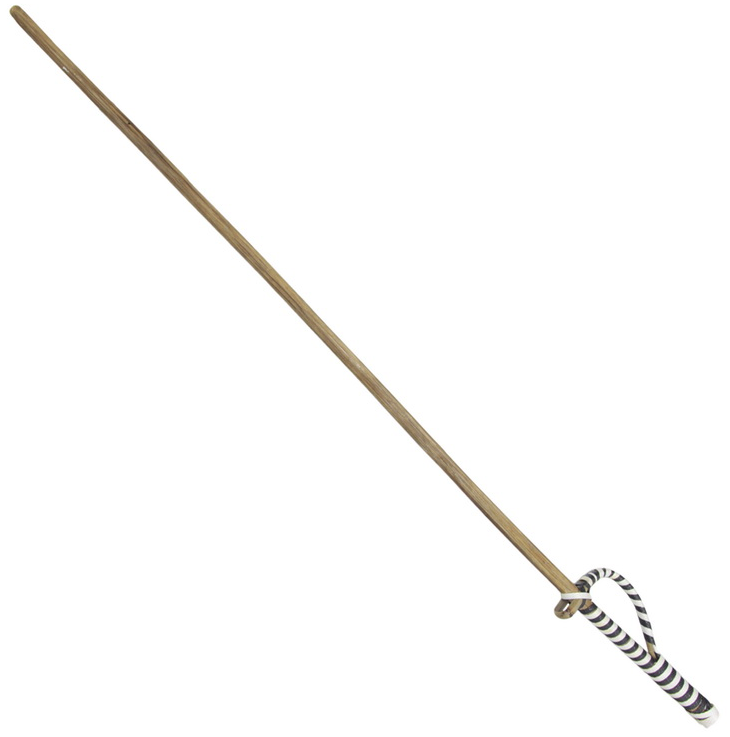 A saber made of rattan for Krabi-Krabong
A saber made of rattan for Krabi-Krabong
(photo credit: http://tsuksapan.com)
Ritual and Steps in Krabi-Krabong
1. Wai Khru
As with all ancient Thai arts, the performance of Krabi-Krabong begins with Wai Khru, a ritual in which students pay respect and homage to teachers. For Krabi-Krabong, the wai khru ritual must be performed three times to remind the fighters of their teachers’ words, to show loyalty to the king because in ancient times, Krabi-Krabong was usually performed for the king, and to express gratitude to parents, teachers, and those who have shown them kindness.
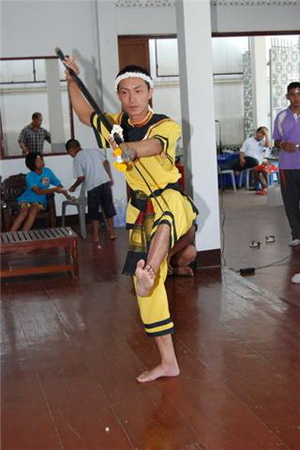
(photo credit: http://www.oknation.net/blog/g-94/2009/11/05/entry-1/comment)
2. Four-direction dance (the Brahma’s dance)
This four-direction dance can be performed either sitting or standing, and must be done in four directions. If one fighter performs the dance sitting, the other must perform it standing. The purpose of this ritual is to lift the fighters’ morale and to remind them of the Brahmavihara 4 principle (benevolence, compassion, empathetic joy, and equanimity) on how to coexist peacefully in society.
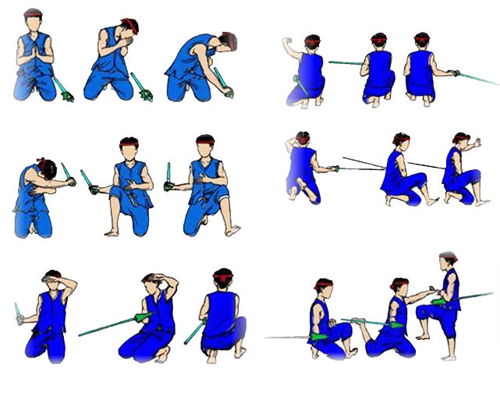
(photo credit: http://thn232755physical.blogspot.com/2015/01/blog-post_20.html)
3. Weapon dance
The weapon dance is a demonstration of the fighters’ skills. Each fighter must perform at least one of the twelve dance moves with the weapon of choice.
4. Walking the ring
Each fighter must walk to the end of the ring and return to their original spot. As they approach each other, both of them must move a little bit to their left and only let their weapons to make contact. The fighters will have an opportunity, while walking the ring, to observe and intimidate each other, and play a psychological game before the game begins.
5. Fighting
The fighters apply every trick, tactic, and move that they have learned to defeat their opponents. The unique rhythmic and elegant choreography of Krabi-Krabong is guided with a set of six basic moves “lower, closer, lift, lunge, plunge, and lead.” At this stage, the equipment will be changed from the dance equipment to the fight equipment which are similar in every way except for the fact that the latter is plain and not decorated. The battle is appreciated for its realness and accuracy according to the martial arts theory.
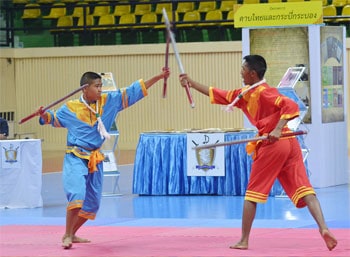
(photo credit: https://www.educatepark.com/story/history-of-krabi-krabong/)
6. Forgiving
At the end of the battle, both fighters will apologize to each other for any mistakes that might have been made.
Values
Krabi-Krabong is a non-violent form of martial art, as evidenced by the fact that real weapons are not used, with the purpose to build discipline and patience in learners. From the martial art viewpoint, the moves and skills of Krabi-Krabong are useful as self-defense. In terms of health and sport, it allows us to train every part of the body. In the least expected aspect, students can earn additional income by performing Krabi-Krabong. Reputable universities in Thailand also set a quota for talented students in Thai martial arts, and some even support them with scholarships to study abroad. In terms of life lessons, Krabi-Krabong teaches learners to respect and be grateful to their teachers, a virtue that Thais believe will pave the way for a prosperous life.
Krabi-Krabong Today
Although Krabi-Krabong is a unique martial art of Thailand and is second to none in its striking techniques and profoundness, it is unfortunate that people nowadays rarely have the opportunity to truly grasp the essence of Krabi-Krabong. Some question its relevance to the modern world and its place in the school curriculum. Some perceive it as ancient, obsolete, and outdated. These perceptions are rather disheartening, but they are just an accumulation of a number of factors, whether the lack of promotion, the level of experience and passion of teachers, and the fact that students have to learn this art just because it is on the curriculum, not because they can choose it based on their interests.
That being said, it is never too late to revive Krabi-Krabong. Today, many schools are striving to modernize this martial art, erasing the boring image in the eye of the younger generations. Some schools have combined moves from gymnastics, boxing, and other types of fighting with Krabi-Krabong. Mastering this art is not easy and takes perseverance and dedication, but with efficient promotion, regular competitions, and passionate teachers, Krabi-Krabong is now on its way back on the stage to inspire more young people to explore a whole new world of this Thai ancient martial art.
Sources
____________________________________________________________________________
Author: Soonyata Mianlamai
24 August 2022


